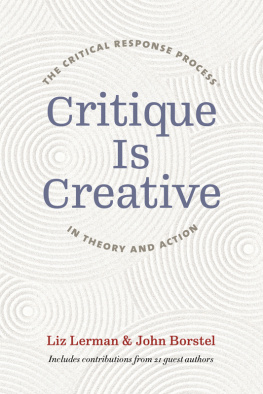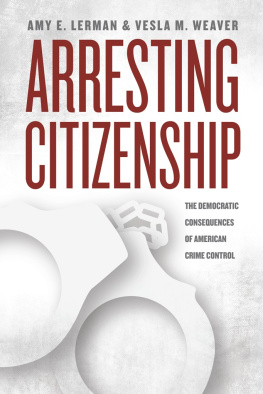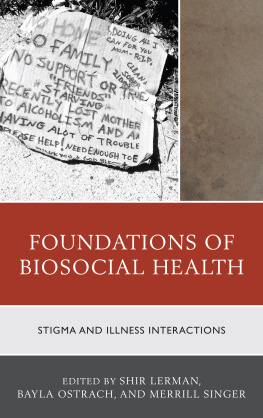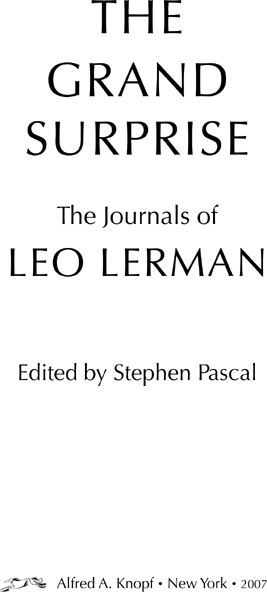ACKNOWLEDGMENTS
T ransforming the materials left by Leo Lerman into this volume required the encouragement, guidance, and contributions of manyarchivists and editors, freelancers and friends. I cannot list all of them here, but my gratitude to each is nonetheless genuine.
First among the work's supporters stand S. I. Newhouse, Jr., and Victoria Newhouse, whose enthusiasm helped launch this project and whose aid and cooperation never ceased. Also crucial to accomplishing the task was Columbia University's Rare Book and Manuscript Library, to which Leo bequeathed his papers. Jean Ashton and Bernard Crystal there showed remarkable adaptability by leaving this archive in my custody until the job could be finished.
Leo's files held a great deal, but many of his letters, photographs, articles, and unfinished projects required searching. In these quests, I relied on the guidanceand often the toilof archivists. Exemplary were those at the Bei-necke Rare Book and Manuscript Library, both the Cond Nast Archive and Library, the Deutsche KinemathekMarlene Dietrich Collection Berlin, the Fairchild Archive, the Getty Research Institute, the Howard Gotlieb Archival Research Center, the New York Public Library's Manuscripts and Archives Division, the New York Public Library for the Performing Arts, the University of Wyoming American Heritage Center, and, again, Columbia University. Working with each of these institutions was rewarding, whatever we finally found.
Ultimately, I drew a large share of this collection from letters written by Leo, and most of them came through the generosity of his friends or their descendants and trustees. My sincere thanks go to Forest Hunter (for Richard Hunter's letters from Leo), Kenward Elmslie (Ruth Landshoff-Yorck's), Peter Riva and Silke Ronneburg (Marlene Dietrich's), Amy Gross (hers), and Alan Schwartz and Gerald Clarke (Truman Capote's). For providing rarely seen photographs from family collections, I am indebted to Emily Harding, Alexandra Plaut Hekking, Nancy Lerman, and Jane Imbs Trimble.
Dozens of Leo's friends and family members told me stories and answered questions. Among the most generous were Robert Davison, Eugenia Halb-meier, Joel Kaye, Leo's cousin Allen Lippman, and Leo's niece Janet Lerman-Graff My own colleagues and friends also helped continually in this effort. I went for expertise and advice repeatedly to Gini Alhadeff, Christopher Baswell, Charles Rowan Beye, Micah Bucey, Cynthia Cathcart, David Cronin, Joan Feeney, Christopher Gates, Lucinda Karter, Lisa Moore, Deirdre McCabe Nolan, Jane Sarnoff, and Tommy Tenhet.
For Knopf's expert handling of this very complicated book, I am particularly indebted to its editor, Robert Gottlieb; his assistant, Alena Graedon; designer Iris Weinstein; production manager Tracy Cabanis; and my production editor, Kathleen Fridella.
This endeavor lasted more than a decade. Some of the most helpful people have not, alas, lived to read it. Heartfelt thanks must go posthumously to Richard Hunter, for many hours of delightful reminiscence, and to Elian Pascal, for years of encouragement and deep insight.
Thanks, of course, but also truly deep gratitude go to Gray Foy. He remembered everything and withheld nothing. In preparation of this book, Gray was ever helpful, thoughtful, and frankas he was for so many years with Leo. Without him, much less would have been accomplished, then or now.
INTRODUCTION
W hen Leo Lerman appears in other people's memoirs, it is often as the host of some all-star gathering in postwar Manhattan. His parties began in the early forties, with dinners for a few smart friends whom he had met working as a Broadway stage manager or through reviewing books for the New York Herald Tribune. By the autumn of 1947, these gatherings had grown into a Sunday-night open house in his book-strewn apartment on East Eighty-eighth Street. Then a writer for Vogue, Harper's Bazaar, and Glamour magazines, he was earning only enough to buy jug wine and rat cheese, but Truman Capote and Anas Nin were not walking up five flights for the canaps. They came, as did scores of what today we call boldface names, for the conviviality, for Leo's ribald and mischievous fun, and to meet people they wouldn't meet anywhere else.
All his life, Leo minted new friendships at a brisk pace. Stage-managing in the Catskills and on Broadway he had met Imogene Coca, John Houseman, and lyricist John Latouche; a German refugee, Eleonora von Mendelssohn, introduced him to a stellar circle that included Marlene Dietrich, Nol Coward, and Luise Rainer; through writing a Vogue feature called Before Bandwagons, he befriended avant-garde architect Frederick Kiesler and literary critics Lionel and Diana Trilling; a summer of late-night games (and very little writing) in 1946 at the Yaddo artists' colony brought friendships with Truman Capote, Carson McCullers, and Katherine Anne Porter. But Leo also knew how to work a room, and friends beget friends. On any given Sunday evening at Leo's, Jane Bowles, Gore Vidal, Gypsy Rose Lee, Dawn Powell, or Carl Van Vechten might appear. Suddenly, that little one-bedroom apartmentand the stairway climbing to itbecame a weekly attraction.
What made Leo's parties extraordinary was not only the caliber of the guests, but also the mix of them. He brought together different sets of people on a spectrum that included art, music, theater, literature, film, society, and demisociety, as well as the shopkeeper down the street. Parties were the laboratory in which he encouraged people to take an interest in one another's work. What friends often remember most fondly about Leo is how he changed their lives by a casual introduction or an offhand suggestion.
Among New York's movers and makers of art, Leo Lerman grew legendary as a man who knew everyone and had seen everything. For fifty years, it seemed he attended every debut, opening, and vernissage in the city and had the crowd at his place to celebrate afterward. He peddled his knowledge of the late great and the up-and-coming to a dozen publications. Through decades of reporting on art and entertainment and, perhaps more important, years of counseling, introducing, and prodding talent, Leo Lerman helped steer American culture. His lasting significance, however, may lie in his role as an observer of the lives and art swirling around him.
Shortly after high school (the end of his classroom education), Leo started reading the works of Virginia Woolf and Marcel Proust. Their novels forever altered his outlook and delivered him to a life of literary ambition and frustration. As many writers have done, Leo dreamed of becoming his generation's Proust, a seismograph of the social upheavals in his lifetime. Some of his earliest journals outline his imagined novel's content and plot, and a prime motive for his keeping a notebook for decades remained documentation, as he dashed down observations and quotations to use in an eventual tribute to his time and his friends.








